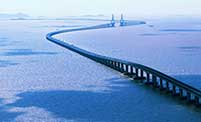

GUANGZHOU, Jan. 3 -- The Pearl River Delta region in south China's Guangdong Province has seen improving air quality in the past few years, local authorities said Sunday.
The density of PM2.5, tiny and particularly hazardous airborne particles, fell to 34 mg per cubic meter in 2015 from 58 mg per cubic meter in 2007, according to the provincial environmental protection bureau.
The level nears the healthy maximum of 35 mg per cubic meter set by the Chinese government.
The delta region, a manufacturing center, includes nine cities such as Guangzhou, Shenzhen, Dongguan, Foshan and Zhongshan. It is in sharp contrast to many northern regions suffering severe smog.
Despite declines in PM2.5 levels, the region faces rising ozone pollution, especially in cities of Guangzhou, Foshan, Dongguan and Zhaoqing, said Zhong Liuju, the bureau's chief air expert.
In the past few years, the authorities have set safe emission standards for volatile organic compounds in industries like plating, printing and furniture to combat ozone pollution, Zhong said.
The measure has helped to cut ozone pollution peaks but the average level still rises by 0.8 mg per cubic meter a year, he said.
 Are these the world’s scariest landing strips?
Are these the world’s scariest landing strips? In pics: Left behind children in China
In pics: Left behind children in China Eight modern day engineering marvels of China
Eight modern day engineering marvels of China Chinese beauty with sexiest bottom
Chinese beauty with sexiest bottom Charming female bodybuilders of Chengdu University
Charming female bodybuilders of Chengdu University Polish sports stars strip off for risqué calendar
Polish sports stars strip off for risqué calendar Spectacular aerial photos of the Three Gorges
Spectacular aerial photos of the Three Gorges Contestants of Mrs. Globe pose for photo in Shenzhen
Contestants of Mrs. Globe pose for photo in Shenzhen
 Bikini models attend hot pot banquet in Hefei
Bikini models attend hot pot banquet in Hefei Top 20 hottest women in the world in 2014
Top 20 hottest women in the world in 2014 Top 10 hardest languages to learn
Top 10 hardest languages to learn 10 Chinese female stars with most beautiful faces
10 Chinese female stars with most beautiful faces China’s Top 10 Unique Bridges, Highways and Roads
China’s Top 10 Unique Bridges, Highways and Roads Face of China 2015
Face of China 2015 A hard year 2015’s stories
A hard year 2015’s stories Smartphone makers jockey for dominance of Chinese market
Smartphone makers jockey for dominance of Chinese market Film star's posts stirs debates on Chinese, foreign medical services
Film star's posts stirs debates on Chinese, foreign medical servicesDay|Week